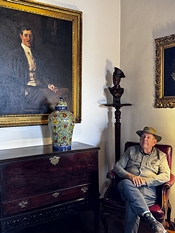![]()
About Resource Library
Resource Library is a free online publication of Traditional Fine Arts Organization (TFAO), a non-profit organization supported solely by donations. Resource Library is devoted to American representational art. Please see How Resource Library differs from paper-printed art publications. The TFAO Free Online Digital Library permanently archives Resource Library's published articles and essays.
What you will find
Resource Library includes aspects of both a scholarly journal and a magazine for broad readership. Maintaining a balance between both emphases, it offers an interconnected body of knowledge including methods and styles of artistic expression, changing cultural emphases over time, history of art museums, galleries and art centers, academies, associations and ateliers, art colonies, clubs and societies and other relevant information.
The content time line spans the pre-Colonial period to the present and covers significant artistic achievement in every state in the United States.
Since 1997 Resource Library and its predecessor Resource Library Magazine have cumulatively published online over 1,350 articles and essays written by hundreds of identified authors, thousands of other texts not attributable to named authors, plus 24,000 images, all providing educational and informational content related to American representational art.
Texts and related images are provided almost exclusively by nonprofit art museums, galleries and art centers. The vast majority of published materials relate to museum exhibitions. Pages on services to institutions and scholarly text from private sources describe how the publication serves both the public and its sources of materials.
Many Resource Library articles and essays concerning exhibitions are accompanied by materials such as checklists, gallery guide texts, wall panel and extended label texts, audio tour scripts and in-house magazine articles. These materials are often not available online elsewhere, providing scholars, curators, teachers, students, collectors and other individuals a rich source of knowledge.
In late 2016 Resource Library ceased inviting institutions and individuals to submit materials for publication consideration in favor of concentration in gathering online information from other sources to place in Topics in American Art, a TFAO catalogue containing Resource Library articles and essays; in-depth links to other online texts, video and audio recordings; references to DVDs, paper-printed books, articles, and more. For more see Recent Developments and Future.
What you won't find
User-tracking cookies are not installed on our website. Privacy of users is important to us. Our pages are loaded blazingly fast. We want you to view Resource Library content as quickly as possible. Resource Library contains no advertising and is 100% non-commercial.
How to find content
To access thousands of texts published online in Resource Library, please see Topics in American Art, a TFAO catalogue which lists all articles and essays. Topics also explains how to research topics not listed. Texts are also listed by source in the Art Museum, Gallery and Art Center Index, the Author Study and Index, which lists articles and essays by author name, and the Chronological Index, which lists articles and essays by date of publication. Also, if a Resource Library text discusses deceased American artists, it may be referenced in America's Distinguished Artists, another TFAO catalogue.
Overall trustworthiness and reliability
Trustworthiness and reliability of online publications are in the eye of the beholder, although there are indicators to help readers make informed judgments. Here are some questions to consider, with related commentary about Resource Library:
Accuracy and reliability of texts with an identified author
Included with each published article or essay by a named author, Resource Library provides to readers information useful for judging accuracy and reliability of the content. Items include how to reach the named author and/or copyright holder, plus information about the grantor of permission to publish the content.
Accuracy and reliability of texts not attributed to an author
Texts and images from institutions have typically been sent to Resource Library by staff members including curators, executive directors and media relations personnel. Certain texts not attributed to an author -- which may include gallery guide texts, wall panel and labels texts -- plus audio tour scripts and checklists, have been usually written or compiled by exhibition curators. News releases have been usually written by media relations staff, who gather information from curators before composing the releases. See descriptive information on staff positions and definitions in our Museums Explained. Less frequently, news releases have been written by media relations firms retained by nonprofit organizations. Resource Library does not inject its own critique or opinions into published texts. Included with each discrete article is information about the source of the material and how to reach that source for confirmation or further questions.
More about Resource Library:

(above: Edmund Ashe, Hunter with Mule, c. 1920, oil on masonite, 24 x 20 in. Johnson Collection, Spartanburg, South Carolina. Public domain, via Wikimedia Commons)
How to find content on our site using search engines
Conduct keyword searches within our website and Resource Library, a collection of articles and essays honoring the American experience through its art, using the advanced search feature of these search engines:
Or, before entering keywords in a basic search, enter site:tfaoi.org
Also see Indexes and information retrieval for more information.

(above: J. P. Hazeltine, Editor of Resource Library and Founder, Traditional Fine Arts Organization. Photo 2024 by Tracey Hazeltine)
![]() Return to home page of Resource Library
Return to home page of Resource Library
*Tag for expired US copyright of object image:

Copyright 2024 Traditional Fine Arts Organization, Inc., an Arizona nonprofit corporation. All rights reserved.